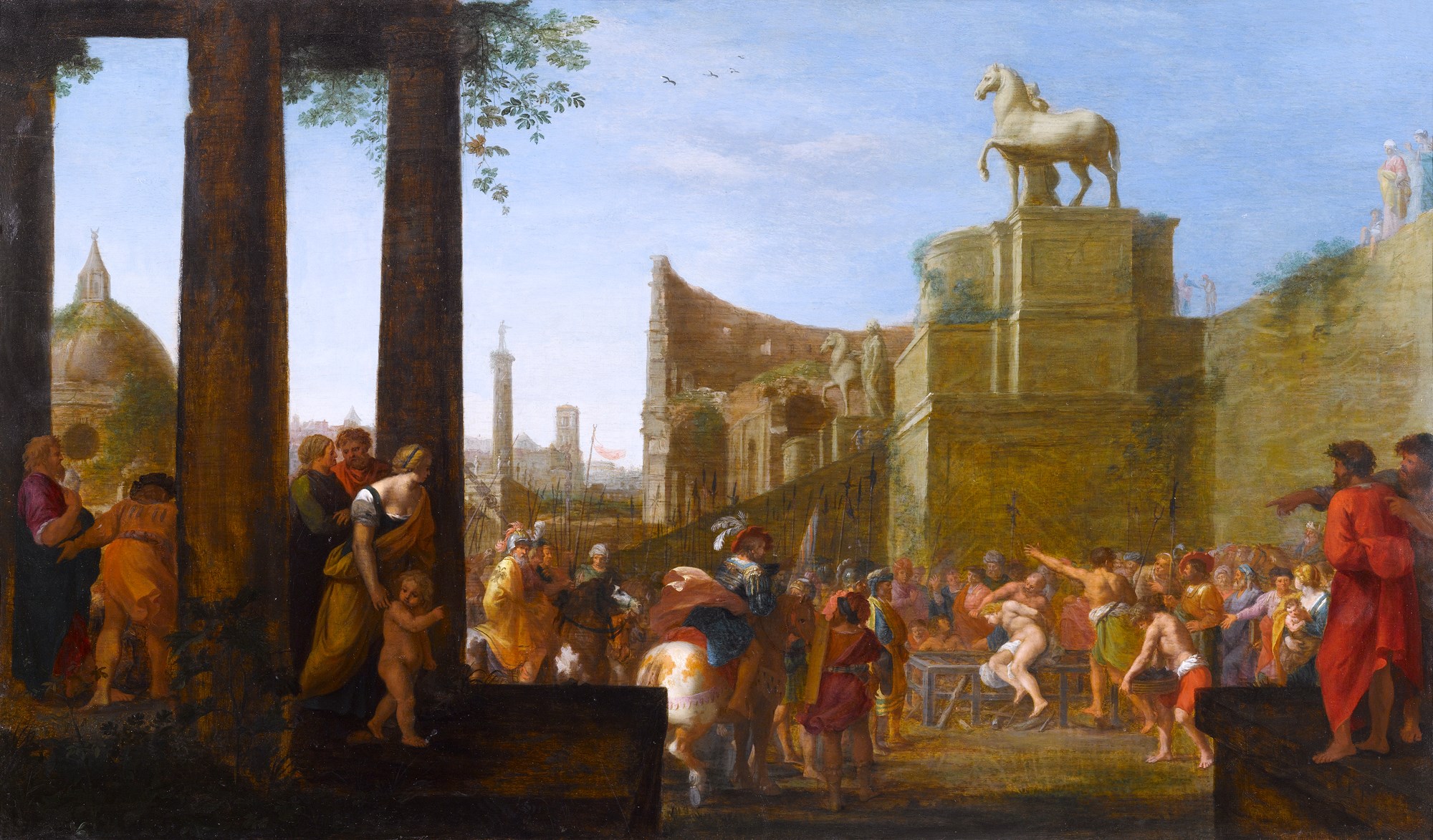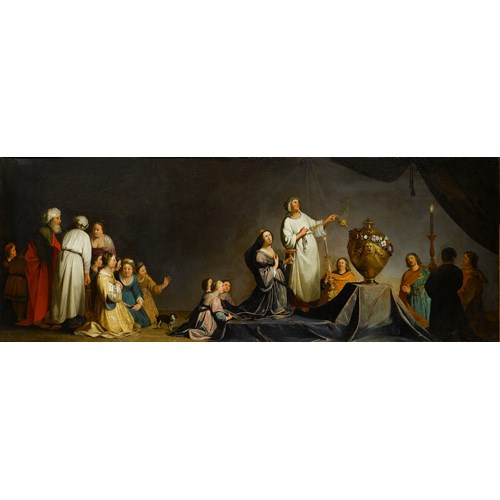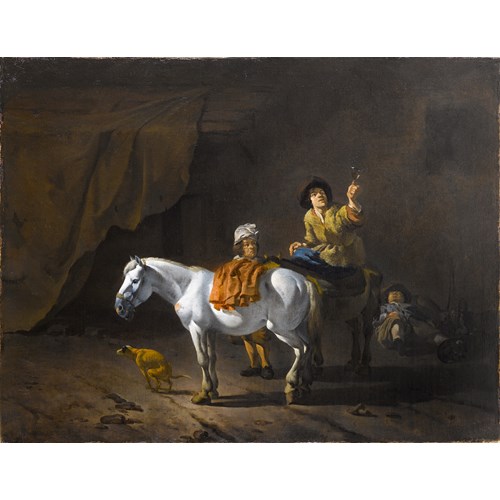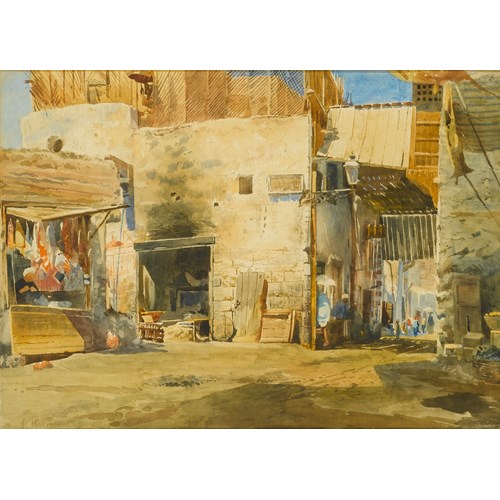Cornelis van Poelenburch
The Martyrdom of Saint Lawrence
Epoque 1600-1750, 17th century
Origine Germany
Medium Oil on panel
Dimension 35.5 x 58.4 cm (14 x 23 inches)
St Lawrence was one of the seven deacons of Ancient Rome under Pope Sixtus II (d. 258), with particular responsibility for the Church’s treasury and for distributing alms among the poor. When Sixtus II died, Lawrence was ordered to surrender the Church’s wealth to the Roman authorities, but instead gave away as much as he could to the impoverished populace of the city. After three days he presented to a Roman prefect the poor, the crippled, the blind and the suffering, saying that these were the true treasures of the Church. This act of impudent defiance led directly to his martyrdom.
The Martyrdom of Saint Lawrence is an early work of Cornelis van Poelenburch, painted during his stay in Italy, a visit which was to be the defining influence on the whole of his career. The painting is part of a group of five identified by Nicolette Sluijter-Seijffert that stand slightly apart from Poelenburch’s usual early work, because of the prominent role given to the figures. This group was painted in the latter part of his Italian sojourn, during his stay in Rome, c. 1621-1625, and uncharacteristically, none are set in an open landscape.¹ Instead all are set either in Rome, or just outside its walls. The present work is the only one not painted on copper, and of the other four, the painting closest to The Martyrdom of Saint Lawrence is the National Gallery of Canada’s Clorinda Saving Olindo and Sofronia from the Stake.² Compositionally the two paintings are very similar, with tall columns dominating looming over several figures to the left of the foreground, from which the eye leads to the central scene of a nude prisoner surrounded by a crowd. The crowds are flanked on the right by a high wall and the instantly recognisable entrance to the Piazza del Campidoglio in Rome, whilst in the background is a more general capriccio.³
The accuracy with which Poelenburch depicts the capriccio settings in these two works is an interesting issue worth examining. The obvious shared architectural feature both Saint Lawrence and Clorinda share is, as already mentioned, the depiction of the entrance to the Piazza del Campidoglio. The steep ramped staircase is the cordonata capitolina, designed by Michelangelo (1475-1564)to provide a dramatic route from the bottom of the Capitoline Hill to his remodelled piazza. The two huge equestrian statues are depictions of the divine twins Castor and Pollux, known collectively as the Dioscuri. Although Michelangelo placed them at the top of his cordonata, they actually dated from antiquity, and the monumental impression they made obviously appealed to Poelenburch.
The accuracy of his depictions should be unsurprising as ‘Poelenburch spent much of his energy sketching various antique ruins and sites in and around Rome.’⁴ Indeed, the depiction of the Colusseum in Saint Lawrence is clearly derived from one of these sketches, today in the Rijksmuseum’s collection. However, it is plain that despite this extensive studying of Roman ruins, Poelenburch was not overly concerned with topographical accuracy, rather he wanted to create an impression of Rome, and its associations with classical antiquity. For example, although the triumphal column in the background of Saint Lawrence could well be Trajan’s Column, it impossible to say, and the domed church on the left hand side bears closer resemblance to the Santa Maria del Fiore in Florence, than to Rome’s St Peter’s. This relaxed attitude to detailed accuracy extends to the dress of the figures in both St. Lawrence and Clorinda, in which figures in ancient togas mingle alongside those dressed in sixteenth and seventeenth-century garb.
In the aforementioned group of five, highlighted by Sluijter-Seijffert, there is a second depiction of The Martyrdom of Saint Lawrence, today housed in Kassel.⁵ Compositionally the two works are very different, but along with their shared interest in classical antiquity, both paintings demonstrate a close observation of early sixteenth century Italian art. Many of those High Renaissance paintings, that Poelenburch had clearly studied, had a shared theme in the exploration of the nude. For example the martyr in the Kassel Saint Lawrence probably derives from Cornelis Cort’s engraving after Titian, and the contorted nudes in both Saint Lawrence paintings are the most arresting figures in each work. The nude figure would be a constant theme throughout Poelenburch’s career, but in the muscular twisting figures of these early works, one can see the impact that living in Italy was having upon his art. Although no sketches remain, it is clear from his paintings that he must have studied some sixteenth-century painters extremely closely, particularly Pontormo in Florence, and Raphael in Rome.⁶ The motif of Clorinda arriving on horseback probably comes from Raphael’s fresco, The Expulsion of Heliodorus (Stanza di Eliodoro, Vatican) and although it is less explicit, the idea of a prisoner being grasped by the hair, as our Saint Lawrence is, can be found in Raphael’s The Battle of Ostia (Stanza dell’incendio del Borgo, Vatican).
Poelenburch trained in Utrecht under Abraham Bloemaert, but it was his lengthy visit to Italy as a young man that was to have the most dramatic impact on his art. He was in Italy from 1617 to 1625, mostly in Rome, although between 1618 and 1621 he worked Cosimo II de Medici, Grand Duke of Tuscany (1590-1621) in Florence. During this period he absorbed a vast range of influences, from the antique and the Italian Renaissance, which have already been discussed, to the work of artists such as Adam Elsheimer (1578-1610) and Paul Bril (1554-1626), fellow Northern artists whose time in Rome also transformed their work. Whilst in Rome he also became a founding member of the Bentvueghels or Schildersbent, a famous society of mostly Dutch and Flemish artists who were active in that city for about a century from 1620 onwards.
Poelenburch returned to Utrecht in 1626, and quickly became one of the region’s leading artists, securing a commission to paint a picture for the Princess Amalia van Solm (1602-1675), which was to be gifted to her by the States of Utrecht.⁷ This commission, and the resultant status it granted him, allowed Poelenburch to develop a large studio of assistants, and he soon found great success and popularity.⁸ His religious and mythological scenes were avidly sought after by both courtly patrons and private collectors in Utrecht and beyond. In 1638 Poelenburch was invited to England to work as a court artist for Charles I (1600-1649), in whose employ he remained for four years. This reflects the fact that during his lifetime Poelenburch was one of the few Dutch Golden Age painters to achieve international renown.
Poelenburch’s small, highly refined paintings usually had a biblical or mythological subject, set within a landscape, and often with nude figures. His work combines a masterly control of the soft light of the Campagna, with the energetic figures, inspired by ancient sculptures and the artists of the Italian Renaissance. Although St Lawrence is a slightly unusual work, given its urban setting, the technique and quality it contains demonstrate why Poelenburch is generally considered the most important of the first generation of Dutch Italianate painters.
¹ Sluijter-Seijffert, N., Cornelis van Poelenburch 1594/5 – 1667: The Paintings (John Benjamins, Amsterdam, 2016), p. 81.
² For a detailed discussion of Clorinda, see Waddingham, M., ‘A Poelenburgh in the National Gallery of Canada’, in Bulletin (National Gallery of Canada, no. 26, 1975.
³ There is a copy of the right hand section of our Saint Lawrence, painted on copper that was sold 10 June 2008, Casa d’aste Babuino, Rome, lot 102.
⁴ Chong, A., ‘The Drawings of Cornelis van Poelenburch’, in Master Drawings, vol. 25, no. 1, (Spring, 1987), p.9.
⁵ In addition to Ottawa’s Clorinda, and the two Saint Lawrence paintings, Sluijter-Seijffert identifies the Louvre’s Stoning of Saint Stephen (inv. no. 1082), and the National Gallery of Art, Washington’s Christ Carrying the Cross with Veronica (inv. no. 2007.49.1), as also being part of this small group from the early 1620s, where the figures are given greater prominence than usual by van Poelenburch, and all of which are set in Rome. For a full discussion see Sluijter-Seijffert, pp. 81-85.
⁶ Chong, p. 11.
⁷ Banquet of the Gods on Earth, Anhaltische Gemäldegalerie Schloss Georgium, Dessau, inv. no. 801.
⁸ For a full discussion of Poelenburch’s pupils and assistants see Sluijter-Seijffert, N. C., ‘The School of Cornelis van Poelenburch’ in In His Milieu: Essays on Netherlandish Art in Memory of John Michael Montias. Ed. A. Golahny, M.M. Mochizuki, and L. Vergara. (Amsterdam University Press, 2006), pp. 441-454.
Epoque: 1600-1750, 17th century
Origine: Germany
Medium: Oil on panel
Signature: Signed with initials 'C.P.F.' (lower right).
Dimension: 35.5 x 58.4 cm (14 x 23 inches)
Provenance: Joannes Baptista Fratacolla;
his sale, van der Schley, Amsterdam, 26 April 1813, lot 50, ƒ18.10;
where bought by Louis Bernard Coclers (1740-1817);
A. Philips-Neven, Maastricht;
his sale, Frederik Muller & Cie, Amsterdam, 24-25 March 1892, lot 96;
in the family of the previous owner for at least 70 years.
Literature: Nicolette Sluijter-Seijffert, Cornelis van Poelenburch 1594/5 – 1667: The Paintings (John Benjamins, Amsterdam, 2016), cat no. 80, pp. 85, 316, fig. 70.
Plus d'œuvres d'art de la Galerie









